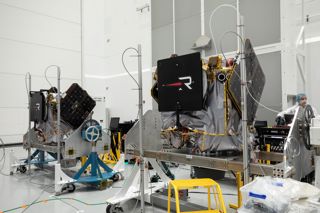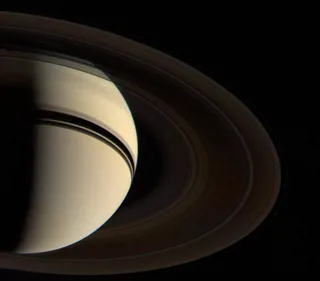
What's Happening in Space: September 2025
- 8th Sep 2025
- Author: Dhara Patel
A summary of space events through the month
Our very own Space Expert Dhara Patel is here with the latest news on events happening this month in the space sector!
Throughout September – spot the International Space Station
From Leicester, there may be sightings throughout the second half of August to spot the International Space Station (ISS) moving across the sky. Download NASA’s Spot the Station app using the App Store or Google Play to find out when and where to spot the largest artificial satellite overhead from your location. It’ll look like a bright star moving relatively quickly across the sky (generally from west to east) and will be visible to the naked eye.
Throughout September – Stargazing challenges / National Space Centre - Space NOW! podcast
Each month, the National Space Centre will be sharing a trio of stargazing challenges for everyone to have a go at. From spotting the Moon and familiar star patterns, to catching meteor showers and some deep sky objects. Check out the Space Centre's Stargazing Challenges - September 2025 blog for more details.
And NSC will also be going beyond the headlines unpacking some of the current space news stories in our podcast, so tune into Space NOW! to listen to new and previous episodes, or watch on YouTube

8th September – Moon and Saturn close in the sky
Look for the waning gibbous moon near Saturn during the evening of 8 September in the eastern sky. The Moon will be in conjunction (sharing the same right ascension – coordinate) with Saturn shortly after 21:00 and as the night goes on, the pair will drift further apart. They’ll rise above the horizon after 20:00, so look out in the early evening in order to spot them as close together as possible. The Moon will appear diagonally up and to the left of Saturn, and the ringed planet will appear as a point of light visible to the naked eye.
In the early evening, they’ll be close to the horizon, so clear views without tall buildings and trees will help you spot them more easily. If you fancy a challenge and have a telescope to hand, you might also be able to spot Neptune which will sit right between the Moon and Saturn, but it will be very difficult to observe with the bright moonlight so close by.
Find out more about close approaches and conjunctions in NSC's astronomical phenomena blog written by David Southworth in the Education team.
16th September – Moon and Jupiter close in the sky
The waning crescent moon will be observable near Jupiter during the early morning of 16 September before sunrise in the eastern sky. The Moon will be in conjunction (sharing the same right ascension – coordinate) with Jupiter shortly after noon later that day and will also be in close approach around the same time, but Jupiter will be drowned out in the daylight at this time. So, the best time to spot the duo close together will be a short while before sunrise, around 5:30 on 16 September - they’ll be visible to the naked eye. The Moon will be positioned above Jupiter, and you might also spot the bright planet Venus closer to the horizon. Check out the astronomical phenomena blog linked above to find out more about close approaches and conjunctions.
19th September – Lunar occultation of Venus
Venus will be extremely close to the very thin waning crescent Moon during the early afternoon of 19 September. In will actually end up being ‘occulted’ which is where the Moon will pass directly in front of it making Venus disappear from view for a short while before it comes back into sight from behind the Moon on its other side. During the day, it’s not possible to spot Venus unless you know exactly where to look as it’s almost completely drowned out by sunlight. But appearing beside the Moon can make it easier to look for. Use a telescope (or binoculars) to look towards the Moon in the southwest from around 12:30 – Venus will sit beside the Moon’s left edge. At 12:52 it will disappear behind the Moon and will reappear from the right edge of the Moon at 14:11. Be very careful when pointing your telescope or binoculars at the sky when the Sun is up as even a slight glance of the Sun’s bright light can cause severe damage to your eyes – make sure your telescope is orientated away from the Sun before looking through it. Check out the astronomical phenomena blog linked above to find out more about occultations and other astronomical phenomena.
21st September - new moon (20:54)
The new moon will occur in the constellation of Virgo. The lack of moonlight interference provides a great time to try and view deep sky objects (especially with the aid of binoculars and telescopes). We have a blog on Moon phases written by Mike Darch in NSC's Education team.

21st September – Saturn at opposition
Because Earth and Saturn have different orbits and orbital speeds, the distance between them is constantly changing. On 21 September, appearing in the constellation of Pisces, Saturn will be on the opposite side of the Earth compared to the Sun so it will roughly be at its closest approach to Earth and its face will be fully illuminated by the Sun. The Sun, Earth, and Saturn will be in ‘syzygy’ or a roughly straight-line configuration. At the time of opposition, Saturn will be brighter than at any other time of the year and will be up all night long making it the best time to view and photograph the planet. It will be bright enough to be seen with your eyes but a pair of binoculars or a telescope will help you see more detail. Catch the spectacle from the late evening on 21 September – it will rise in the east and set in the west the following morning, so ideally look towards the south around midnight. Check out the astronomical phenomena blog above to find out more about oppositions and other astronomical phenomena.
22nd September – autumnal/vernal equinox (19:20)
The Sun crosses the celestial equator going north to south, marking the first day of astronomical autumn for the northern hemisphere. On this day, the Sun will appear directly above the equator and the length of daylight and nighttime hours are about equal. The autumnal equinox marks the end of summer in the UK and from now, the hours of daylight will shorten each day as we approach the winter solstice in December. Find out more in our Equinoxes and Solstices blog by Catherine Muller, previously in our Public Programmes team.
23rd September – Neptune at opposition
Because Earth and Neptune have different orbits and orbital speeds, the distance between them is constantly changing. On 23 September, appearing in the constellation of Pisces, Neptune will be on the opposite side of the Earth compared to the Sun so it will roughly be at its closest approach to Earth and its face will be fully illuminated by the Sun. The Sun, Earth, and Neptune will be in ‘syzygy’ or a roughly straight-line configuration. At the time of opposition, Neptune will be brighter than at any other time of the year and will be up all night long making it the best time to view and photograph the planet. It will still appear faint, and you’ll need a telescope to see the blue point of light that lies over 4 billion km from us. Catch the spectacle from the late evening on 23 September – it will rise in the east and set in the west the following morning, so ideally look towards the south around midnight. It will be located near Saturn which will be visible to the naked eye. Check out the astronomical phenomena blog above to find out more about oppositions and other astronomical phenomena.
24th September – Moon and Mars close in the sky
Look for Mars near the thin waxing crescent moon in the southwestern sky around dusk on 24 September. The moon will be in conjunction (sharing the same right ascension – coordinate) with Mars just before 16:00, but the skies won’t be dark enough to spot the pair at this time. Try and look for them in close proximity a few hours later as the Sun starts to set and the sky begins to darken – but it will be a challenge to spot them before the Moon sets around 19:15. Since the pair will be close to the horizon, clear views without tall buildings and trees is essential to help you observe them. If the skies have darkened enough, Mars will be visible to the naked eye appearing as a point of light sitting slightly further up and to the right of the Moon. Check out the astronomical phenomena blog linked above to find out more about close approaches and conjunctions.

29th September – EscaPADE mission launch
The Escape and Plasma Acceleration and Dynamics Explorers (EscaPADE) is a mission to study the interaction between the Martian atmosphere and solar wind and how this contributed to the planet's atmospheric loss. The twin spacecraft were originally scheduled to launch on the Psyche mission in 2022 but were removed when the Psyche mission was delayed (eventually launching in October 2023), as it would no longer swing past Mars. EscaPADE will now launch on a Blue Origin New Glenn rocket which made its debut at the beginning of this year, and on this second flight it will attempt to land the first stage reusable booster on its sea-based landing platform, ‘Jacklyn’ (something it didn’t manage on its first flight). EscaPADE is part of the NASA Small Innovative Missions for Planetary Exploration (SIMPLEx) program and is scheduled to launch on 29 September from Cape Canaveral, Florida (time tbc).
September? – New Shepard | NS-35 launch
NS-35 will be the thirty-fifth New Shepard spaceflight mission, operated by Blue Origin. This suborbital flight will be an uncrewed mission with more than 40 scientific and research payloads onboard the New Shepard rocket, which will take off from Launch Site One in West Texas. Delayed from August due to booster avionics issues, a new launch date is yet to be set but will likely occur during September. As a suborbital flight, the mission will provide just over three minutes of clean microgravity for science and research to be conducted. Part of the science payload are experiments chosen as part of NASA and Future Engineers' TechRise Student Challenge, which include studies on how we cultivate plants in microgravity, the physics of liquids and medical research. With this flight, the total number of payloads flown on New Shepard will exceed 200.
Please note: As this summary is created at the end of the month before, dates (especially launch dates) can often change or be updated, so this content may become outdated - we always recommend checking on the relevant organisation's pages.
